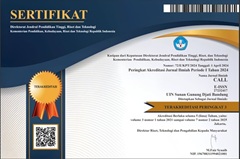SLAVERY IN ‘BILAL: A NEW BREED OF HERO’ AND ’12 YEARS A SLAVE’ FILMS
DOI:
https://doi.org/10.15575/call.v3i1.12509Abstract
This paper discusses slavery in Bilal: A New Breed of Hero film and 12 Years A Slave film. From the title of this paper, it would be known that the objects for this research are Bilal: A New Breed of Hero film and 12 Years A Slave film. The focus of this paper is to seek the portrayal of slavery and its relationship with economic and religion. To analyze both objects, the theory of slavery from Kevin Bales is employed, which sees that slavery is a state marked by the loss of free will. In addition, the theory of Marxism by Karl Marx as a literary theory to assist this research is also used since it is related to examine two antagonistic classes, which in this case, between slave and freeman. They are also used to discuss economic and religion. Besides, the researcher is going to compare both objects by using comparative literature. The method used in this research is descriptive analysis method and comparative literature method. As a result of the analysis, Bilal in the movie is not in accordance with what Karl Marx’s theory that said ‘someone will not contemplate about mental production such as religion, philosophy, and ethics (morality) before he fulfils his economy and basic needs, because maintaining economic power is the motive behind those things’. Bilal does not represent this theory because he is not materialist. Besides, he embraced Islam firmly, so even he was a slave and economically he had nothing, but he chose to prioritize religion (which is included in mental production) before economy (material production).
Â
Keywords: slave; slavery; economy; religion; Marxism
References
Allain, J. (2012). The Legal Understanding of Slavery: From the Historical to the Contemporary. Oxford: Oxford University Press.
Aspers, P. (2010). Alfred Marshall and The Concept of Class. American Journal of Economics and Sociology, 151-165.
Baha, H. (2016). An Introduction of Descriptive Analysis, its advantages and disadvantages. Luneburg: Leuphana Universitat Luneburg.
Bassnett, S. (1993). Comparative Literature: A Critical Introduction. Cambridge: Blackwell Publisher.
Boggs, J. M., & Petrie, D. W. (2008). The Art of Watching Films. New York: McGraw-Hill.
Braudy, L., & Cohen, M. (2009). Film Theory and Criticism, 7th Edition. New York: Oxford University Press.
Eneste, P. (1991). Novel dan Film. Flores: Nusa Indah.
Kothari, C. (2004). Research Methodology: Method and Techniques. New Delhi: New Age International Publisher.
Luxemburg, J. V. (1984). Pengantar Ilmu Sastra. Jakarta: Gramedia.
Marx, K. (1992). Early Writings. London: Penguin Books.
Marx, K., & Engels, F. (1845). The Ruling Class and the Ruling Ideas.
Marx, K., & Engels, F. (1970). Manifesto of The Communist Party. Peking: FOREIGN LANGUAGES PRESS.
Nasution, A. S. (2015). Perbudakan dalam Islam. Ahkam Vol. XV, No.1 Januari, 97.
Sugiyono. (2012). Metode Penelitian Kuantitatif Kualitatif. Bandung: Alfabeta.
Sylvester, T. M. (1999). Slavery Throughout The History: Almanac. Thomson-Gale.
Tyson, L. (2006). Critical Theory Today. New York: Routledge.
Downloads
Published
Issue
Section
Citation Check
License
Authors who publish in CALL agree to the following terms:
- Authors retain copyright and grant the journal right of first publication with the work simultaneously licensed under Attribution-ShareAlike 4.0 International (CC BY-SA 4.0) License that allows others to share the work with an acknowledgment of the work's authorship and initial publication in this journal.
- Authors are able to enter into separate, additional contractual arrangements for the non-exclusive distribution of the journal's published version of the work (e.g., post it to an institutional repository or publish it in a book), with an acknowledgment of its initial publication in this journal.
- Authors are permitted and encouraged to post their work online (e.g., in institutional repositories or on their website) prior to and during the submission process, as it can lead to productive exchanges, as well as earlier and greater citation of published work (See The Effect of Open Access).




